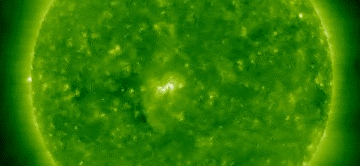Archive 2009
November 24, 2009
Years ago, when solar physicists first witnessed a towering wave of hot plasma racing along the sun's surface, they doubted their senses. The scale of the thing was staggering. It rose up higher than Earth itself and rippled out from a central point in a circular pattern millions of kilometers in circumference. Skeptical observers suggested it might be a shadow of some kind—a trick of the eye—but surely not a real wave.
For full story click here
November 11, 2009
Science now has a more definitive and reliable tool for measuring the sun's rotation when sunspots aren't visible.
For full story click here
November 2, 2009
The Extreme Ultraviolet Imaging Spectrometer (EIS), on board the Japanese-UK-US Hinode satellite, is now generating unprecedented observations enabling scientists to provide a new perspective on the 50-year old question of how solar wind is driven.
For full story click here
September 11, 2009
UCLA atmospheric scientists have discovered a previously unknown basic mode of energy transfer from the solar wind to the Earth's magnetosphere. The research, federally funded by the National Science Foundation, could improve the safety and reliability of spacecraft that operate in the upper atmosphere.
For full story click here
September 3, 2009
Dr. Laura Peticolas discusses her research, her inspiration and how and why scientists sonify data. Podcasted from a talk given at the Exploratorium.
Click here to download her talk (.mp3, 29MB)
Click here for more information
September 1, 2009
Researchers at the University of Warwick have found what could be the signal of ideal wave “surfing” conditions for individual particles within the massive turbulent ocean of the solar wind. The discovery could give a new insight into just how energy is dissipated in solar system sized plasmas such as the solar wind and could provide significant clues to scientists developing fusion power which relies on plasmas.
For full story click here
April 14, 2009
STEREO Reveals the Anatomy of Solar Storms. STEREO spacecraft images and in situ measurements combine to show a complete picture of CMEs that paves the way for predicting solar storms like meteorologists predict hurricanes.
For full story click here.
April 9, 2009
Two places on opposite sides of Earth may hold the secret to how the moon was born. NASA's twin Solar Terrestrial Relations Observatory (STEREO) spacecraft are about to enter these zones, known as the L4 and L5 Lagrangian points, each centered about 93 million miles away along Earth's orbit.
For full story click here.
Feb 13, 2009
Yesterday, Feb. 12th at 1625 UT, an ultraviolet telescope onboard NASA's STEREO-B spacecraft recorded the following images of a faint yet powerful "solar tsunami" eruption through the Sun's lower atmosphere:
 The solar activity has been attributed to Sunspot 1012 which has been crackling with B-class solar flares of late. The low latitude and magnetic polarity of this sunspot identify it as a member of old Solar Cycle 23. It is, in other words, a fossil, albeit a relatively active one. Stay tuned for more flares. (via Spaceweather.com)
The solar activity has been attributed to Sunspot 1012 which has been crackling with B-class solar flares of late. The low latitude and magnetic polarity of this sunspot identify it as a member of old Solar Cycle 23. It is, in other words, a fossil, albeit a relatively active one. Stay tuned for more flares. (via Spaceweather.com)
Jan 28, 2009
January 24, 2009 marks the point at which the two STEREO spacecraft reach 90 degrees separation, a condition known as quadrature. Since the two STEREO spacecraft went into orbit around the Sun at the beginning of 2007, they have been slowly drifting apart from Earth, and from each other. After two years in solar orbit, the two spacecraft have finally reached quadrature.
For full story click here.
Articles About STEREO/IMPACT
Anatomy of a Coronal Mass Ejection: Briefing Material (HTML article published at NASA.gov)
- 14 April 2009
Join STEREO and Explore Gravitational "Parking Lots" That May Hold Secret of Moon's Origin (HTML article published at NASA.gov)
- 9 April 2009
STEREO in Quadrature (HTML article published at NASA.gov)
- 28 January 2009
Scientists wowed by Sun images. (HTML articles published at The Baltimore Sun)
- 26 January 2007
Hopkins and NASA to monitor solar flares. (PDF article published at Baltimore Examiner)
- 25 January 2007
Twin APL_Built Spacecraft Swing Past Moon, Preparing for 3-D Solar Studies (HTML article published at APL @ Johns Hopkins University)
- 23 January 2007
Probe's close-up of Sun eruption (HTML article published at BBC News)
- 29 November 2006
A 3-D Look at The Sun's Eruptions> (HTML article published at Popular Science)
- 13 November 2006



